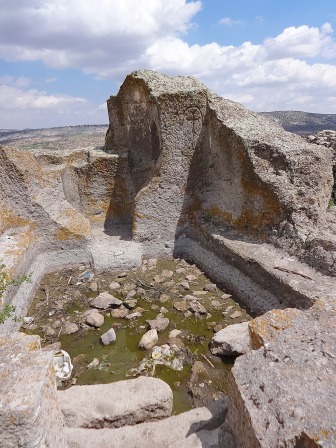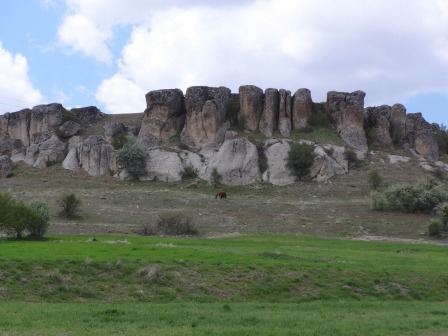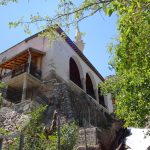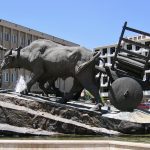Rock-cut village possibly visited by St Paul Gökyurt population: about 400
One of the most interesting side trips you can make from Konya is to Kilistra, an ancient rock-cut settlement roughly 45 km to the southwest on the outskirts of the modern village of Gökyurt.
Kilistra is like a beautiful mini version of the more famous Cappadocia with houses and churches carved out of a rocky plateau that looks from a distance like a set of pinnacles squashed up against each other. Although the odd obvious cavern on the plateau’s exterior gives a clue as to what lies within, most of the churches and other buildings are actually concealed behind a solid wall of rock.
Backstory
Kilistra is thought to have been settled in the 2nd century BC. The town sat astride the King’s Road which had been created by the Persian ruler Darius I in the 5th century BC to link his summer capital at Persepolis (in modern Iran) to Sardis, near İzmir.
This road transited Kilistra on its way from Konya to Antioch-in-Psidia, near modern-day Yalvaç, and some scholars believe that St Paul visited it on his first trip through Anatolia between 47 and 49 AD. There he may have met Timothy to whom he later wrote the letters that now form part of the Bible. However, this is not confirmed fact.
Around the site
The drive to Kilistra from Konya gets more and more picturesque once you turn off the main road onto the one that passes through Akören to Hatunsaray. Eventually you will see two extraordinary ridges of rock rising up on either side of the road. A minor road (unsigned) on the left runs to Kilistra itself where there is a small car park immediately in front of one of the rock-cut churches.
Steps lead up to the Sandıkkaya Kilise (Sandıkkaya Church, Chest or possibly Shrine Rock), an extraordinary, cross-shaped stone structure cut completely clear of the rock in one solid piece, perhaps in the 7th or 8th century.
The church is vaguely reminiscent of the Belli Kilise in Cappadocia’s remote Soğanlı valley, although that has a more sophisticated dome. It is also like the church at Ayazini although in that case there is a rock-cut apse but no dome. Otherwise, it is hard not to be reminded of the hidden rock churches of Lalibela in faraway Ethiopia which, far from languishing in obscurity, form a world heritage site visited by thousands of people every year.
The Sandıkkaya church must date from the Byzantine period. Otherwise there are few clues as to the age of Kilistra’s remaining structures which include huge cisterns, dark grape storage rooms, ancient tombs and many cave-houses. On the summit above the church I identified what looked like an immersion baptismal font with carved crosses on the wall above the basin, as well as what looked like a şaraphane (winery) with a stone floor for treading grapes pierced with a hole through which the juice would drain into a basin below.
 Probable baptistryThe church most closely associated with St Paul, the Sümbül Kilisesi (Hyacinth Church), is actually hidden in the rocks on the opposite side of the road (Lystra). There’s no sign and no path to reach it either.
Probable baptistryThe church most closely associated with St Paul, the Sümbül Kilisesi (Hyacinth Church), is actually hidden in the rocks on the opposite side of the road (Lystra). There’s no sign and no path to reach it either.
Gökyurt itself is a very pretty, if partly ruinous village, with lots of fine houses of wood and stone overlooking the rocks. Most of its erstwhile inhabitants have long since moved away to Konya.
Sleeping
There is nowhere to stay in Kilistra itself but Konya has accommodation to suit all budgets.
Transport info
With a car, leave Konya on the Antalya road and look for signs to Akören on the left. From there follow signs to Klistra-Gökyurt. If you take a taxi you may well need to explain the route to the driver as few visitors head this way.

The rock-cut settlement of Kilistra


